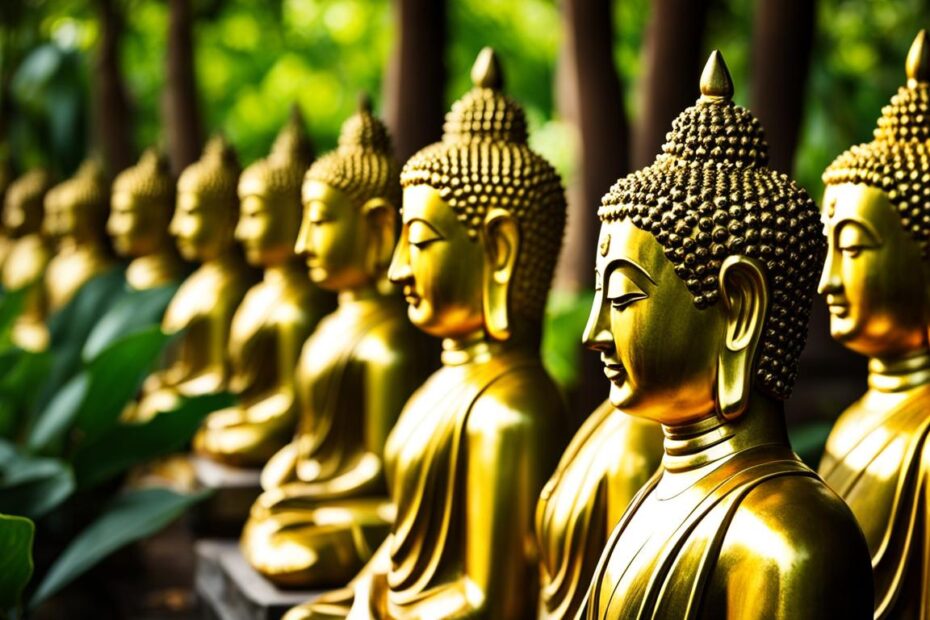Buddhism, a profound and enlightening religion, is adorned with captivating symbolism and revered statues of Buddha. These statues not only serve as works of art but also hold deep spiritual significance. In this article, we will delve into the different types of Buddha statues, their cultural and spiritual importance, and how they have evolved over time.
Key Takeaways:
- Statues or images of Buddha are not merely decorative items; they hold deep symbolism in Buddhism and serve as reminders of the path to enlightenment.
- There are various types of Buddha statues, each representing different aspects of the Buddha’s life and teachings.
- Buddha statues can be made from a variety of materials, ranging from stone and wood to precious gemstones, each carrying its own cultural significance.
- These statues have evolved over time, reflecting the cultural and artistic advancements of different regions.
- In addition to traditional designs, contemporary interpretations of Buddha statues offer a fresh perspective on Buddhist teachings.
The Symbolism of Buddha Statues
The beauty of Buddha statues goes beyond their physical appearance. Each element of these statues holds profound symbolism, reflecting the teachings of Buddhism and guiding practitioners on their spiritual journey. From the posture to the hand gestures, every detail carries a specific meaning that enhances the spiritual experience.
The Posture: Meditation and Enlightenment
The most common posture seen in Buddha statues is the seated or meditating position. This posture represents the Buddha’s own meditation under the Bodhi Tree, where he attained enlightenment. The crossed legs symbolize stability and groundedness, emphasizing the importance of a calm and focused mind for spiritual growth.
The Mudras: Gestures of Wisdom and Compassion
Another significant aspect of Buddha statues is the hand gestures or mudras. Each mudra represents a different aspect of the Buddha’s teachings or portrays a specific state of mind. For example, the Dhyana mudra, with both hands resting on the lap, signifies meditation and inner peace. The Abhaya mudra, with the palm raised, symbolizes fearlessness and protection.
The Facial Expression: Serenity and Wisdom
The serene expression on Buddha statues is intentional, conveying the sense of inner peace and wisdom achieved through enlightenment. The half-closed eyes indicate a state of deep meditation, while the gentle smile represents compassion and joy. These facial features serve as a reminder of the peace and tranquility that can be found within oneself.
By incorporating these symbolic elements, Buddha statues serve as powerful reminders of the Buddha’s teachings and the path to enlightenment. They inspire practitioners to cultivate inner peace, wisdom, and compassion in their daily lives.
| Symbol | Meaning |
|---|---|
| Lotus | Symbolizes purity, spiritual awakening, and the potential to overcome obstacles. |
| Robe | Represents renunciation and detachment from worldly attachments. |
| Urn | Signifies the treasure of spiritual wisdom and the abundance of enlightenment. |
| Third Eye | Symbolizes insight, intuition, and the divine perception of the Buddha. |
| Wheel | Represents the Buddha’s teachings, known as the Dharma, and the cyclic nature of existence. |
These symbols are often depicted alongside the Buddha statues, further enriching their meaning and providing visual cues for contemplation and reflection.
Types of Buddha Statues
There are various types of Buddha statues, each with its own unique characteristics. These statues serve as powerful symbols of Buddhism and hold deep spiritual significance. Let’s explore some of the most commonly seen types:
1. Meditating Buddha
The meditating Buddha statue is one of the most iconic representations of the Buddha. It depicts him in a seated position with crossed legs, hands resting on his lap, and eyes closed in deep meditation. This type of statue symbolizes inner peace, mindfulness, and the pursuit of enlightenment.
2. Laughing Buddha
Also known as the Happy Buddha or the Fat Buddha, the laughing Buddha statue is often depicted with a large belly and a jovial expression. This statue is associated with good luck, happiness, and abundance. It is believed to bring joy and prosperity to its owner.
3. Reclining Buddha
The reclining Buddha statue represents the Buddha in a resting or sleeping pose, typically with his head resting on his right hand. This statue symbolizes the Buddha’s final moments before attaining enlightenment and entering Nirvana. It serves as a reminder of the impermanence of life and the ultimate goal of spiritual liberation.
4. Standing Buddha
The standing Buddha statue depicts the Buddha in an upright posture, with one hand raised in a gesture of fearlessness or teaching and the other hand resting by his side. This statue symbolizes courage, compassion, and the Buddha’s readiness to help those in need.
These are just a few examples of the many types of Buddha statues that exist. Each statue carries its own symbolism and serves as a visual representation of the Buddha’s teachings and enlightened state.
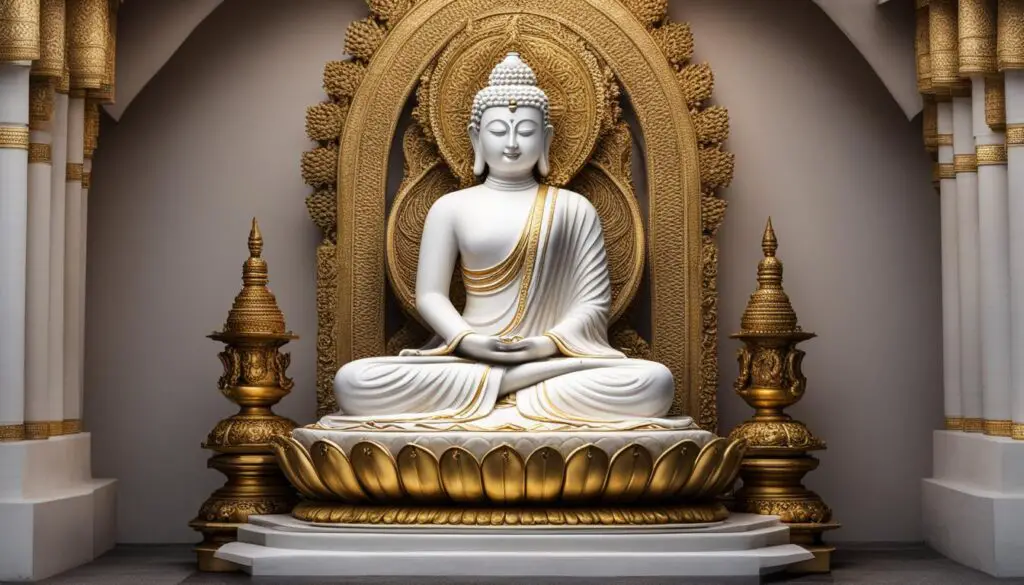
| Type of Buddha Statue | Symbolism |
|---|---|
| Meditating Buddha | Inner peace, mindfulness, pursuit of enlightenment |
| Laughing Buddha | Good luck, happiness, abundance |
| Reclining Buddha | Impermanence of life, spiritual liberation |
| Standing Buddha | Courage, compassion, willingness to help |
Materials Used in Buddha Statues
Buddha statues are crafted using a variety of materials, each chosen for its unique qualities and artistic effects. The choice of material plays a significant role in the overall appearance and symbolism of the statue. Let’s explore some of the commonly used materials and their significance.
Stone
Stone, such as marble, granite, or sandstone, is a popular choice for crafting Buddha statues. Stone statues are known for their durability and timeless beauty. The natural texture and colors of the stone create an organic and grounding presence, enhancing the serenity and spirituality of the statue.
Wood
Wooden Buddha statues have a warm and elegant aesthetic that reflects nature’s beauty. Various types of wood, such as teak, sandalwood, or cedar, may be used. Wood carving techniques allow for intricate detailing and expressive facial features. The use of wood symbolizes the Buddha’s connection to the earth and the impermanence of all things.
Bronze and Brass
Bronze and brass are common metals used in creating Buddha statues. These materials offer longevity and a rich, golden appearance. The statues are often cast using traditional methods, resulting in intricate designs and smooth finishes. The use of bronze and brass signifies strength, wisdom, and the Buddha’s radiant teachings.
Precious Gemstones
Some Buddha statues are adorned with precious gemstones, such as jade, amethyst, or lapis lazuli. These gemstones add a touch of opulence and spiritual significance. Each gemstone carries its own symbolism, with jade representing purity and wisdom, amethyst promoting spiritual growth, and lapis lazuli symbolizing enlightenment and truth.
The materials used in crafting Buddha statues contribute to their visual appeal and convey profound meanings. Whether it is the solid presence of stone, the natural warmth of wood, the radiant glow of bronze, or the exquisite beauty of precious gemstones, each material enhances the spiritual experience and invites contemplation.
The Evolution of Buddha Statues Over Time
Buddha statues have undergone significant changes and transformations throughout history, reflecting the evolving cultural and artistic sensibilities of different regions. These statues serve as timeless reminders of the Buddha’s teachings and continue to captivate the hearts and minds of people around the world.
During the early period of Buddhism, the statues were simple and stylized, representing the essence of the Buddha’s teachings rather than realistic portrayals. These statues often featured a standing or meditating Buddha, with minimal details and little emphasis on facial expressions or intricate features.

As Buddhism spread to various regions, the style and design of Buddha statues underwent significant changes. In countries like India, China, Japan, and Thailand, artists began incorporating intricate details and lifelike expressions into their statues. The statues became more elaborate, showcasing the skill and craftsmanship of the artists.
Table: Evolution of Buddha Statue Styles
| Period | Style | Characteristics |
|---|---|---|
| Ancient Period | Stylized | Simple and abstract representations with minimal details. |
| Classical Period | Realistic | Lifelike features, intricate details, and naturalistic poses. |
| Modern Period | Contemporary | Innovative designs incorporating modern materials and cultural influences. |
In recent times, contemporary artists have also explored new interpretations of Buddha statues. These artworks incorporate modern materials, styles, and cultural influences, while still maintaining the essence of Buddhist teachings. These contemporary statues offer a fresh perspective and add to the diverse range of Buddha artworks available today.
The evolution of Buddha statues not only reflects the changing artistic styles but also signifies the continuous growth and development of Buddhism as a spiritual and cultural tradition. These statues provide a visual representation of the timeless wisdom of the Buddha, inspiring practitioners and art enthusiasts alike.
The Significance of Buddha Statues in Meditation
Buddha statues play a significant role in meditation practice. Many practitioners use a statue as a focal point during meditation, as it helps create a sense of calm and mindfulness. The statue serves as a reminder of the Buddha’s teachings and provides a visual representation of the enlightened state.
The presence of a Buddha statue can create a sacred and serene atmosphere, fostering introspection and mindfulness. The statue’s serene expression and peaceful posture symbolize the Buddha’s attainment of inner peace and liberation from suffering. By gazing at the statue, practitioners are reminded of their own potential to cultivate inner peace and find liberation from the cycle of suffering.
During meditation, practitioners often direct their attention and focus towards the statue. This helps to still the mind and cultivate a deep state of concentration. The statue represents an external anchor that supports the practitioner in staying present and focused. By directing their attention to the statue, practitioners can cultivate a sense of presence and awareness, allowing them to delve deeper into their meditation practice.
Overall, Buddha statues serve as powerful aids in meditation, helping practitioners create an environment conducive to inner peace and mindfulness. They symbolize the Buddha’s teachings and provide a tangible representation of enlightenment. The presence of a Buddha statue during meditation can enhance the practitioner’s connection to the profound wisdom of Buddhism and facilitate a deeper spiritual experience.
The Significance of Buddha Statues in Meditation
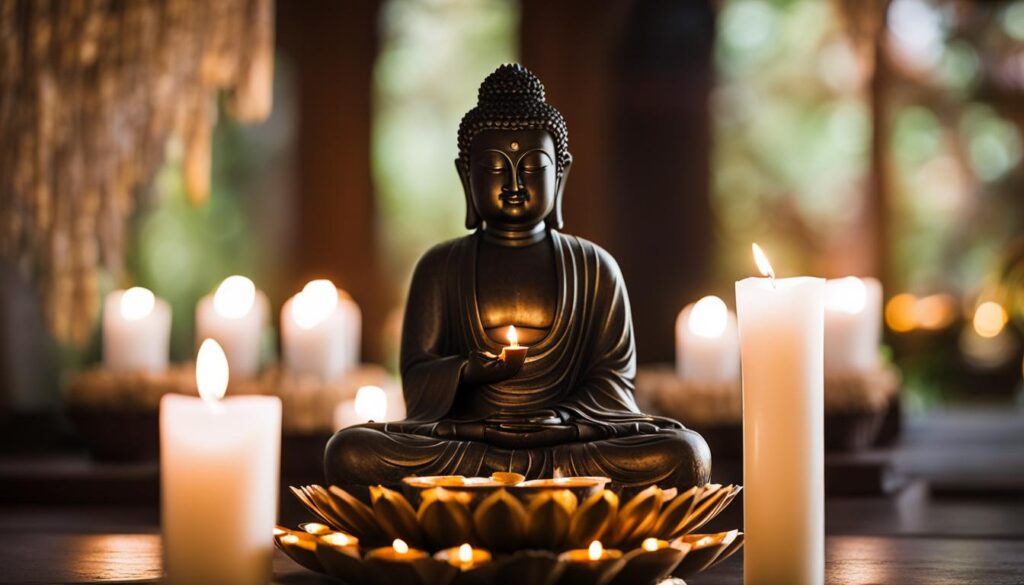
Buddha statues play a significant role in meditation practice. Many practitioners use a statue as a focal point during meditation, as it helps create a sense of calm and mindfulness. The statue serves as a reminder of the Buddha’s teachings and provides a visual representation of the enlightened state.
By gazing at the statue, practitioners are reminded of their own potential to cultivate inner peace and find liberation from the cycle of suffering.
During meditation, practitioners often direct their attention and focus towards the statue. This helps to still the mind and cultivate a deep state of concentration. The statue represents an external anchor that supports the practitioner in staying present and focused. By directing their attention to the statue, practitioners can cultivate a sense of presence and awareness, allowing them to delve deeper into their meditation practice.
Overall, Buddha statues serve as powerful aids in meditation, helping practitioners create an environment conducive to inner peace and mindfulness. They symbolize the Buddha’s teachings and provide a tangible representation of enlightenment. The presence of a Buddha statue during meditation can enhance the practitioner’s connection to the profound wisdom of Buddhism and facilitate a deeper spiritual experience.
Regional Variations in Buddha Statues
Different regions and cultures have their own unique styles and variations of Buddha statues. These regional variations reflect the diversity and richness of Buddhist art and culture. For example, Thai Buddha statues often feature intricate detailing, while Japanese Buddha statues have a more serene and meditative appearance. The variations in style, materials used, and symbolism provide fascinating insights into the different interpretations of Buddhism across various regions.
Thai Buddha Statues
Thai Buddha statues are known for their ornate and intricate designs. They often depict the Buddha in seated or standing postures, with intricate engravings and embellishments. These statues are typically made from materials such as gold, bronze, or wood. Thai Buddha statues are revered for their artistry and craftsmanship, and they are believed to bring blessings, prosperity, and protection.
Japanese Buddha Statues
Japanese Buddha statues, often referred to as “Butsuzo,” have a distinctively serene and meditative appearance. They emphasize simplicity and minimalism, reflecting the Zen influences in Japanese Buddhism. These statues commonly depict the Buddha in a seated meditation posture, with a calm and gentle expression. Japanese Buddha statues are usually made from materials such as wood, bronze, or stone.
In addition to Thai and Japanese styles, there are many other regional variations in Buddha statues, including Tibetan, Chinese, Sri Lankan, and Burmese styles. Each style brings its own unique cultural and artistic elements, while still embodying the core teachings of Buddhism. These regional variations highlight the diversity and adaptability of Buddhism as it has spread throughout the world.
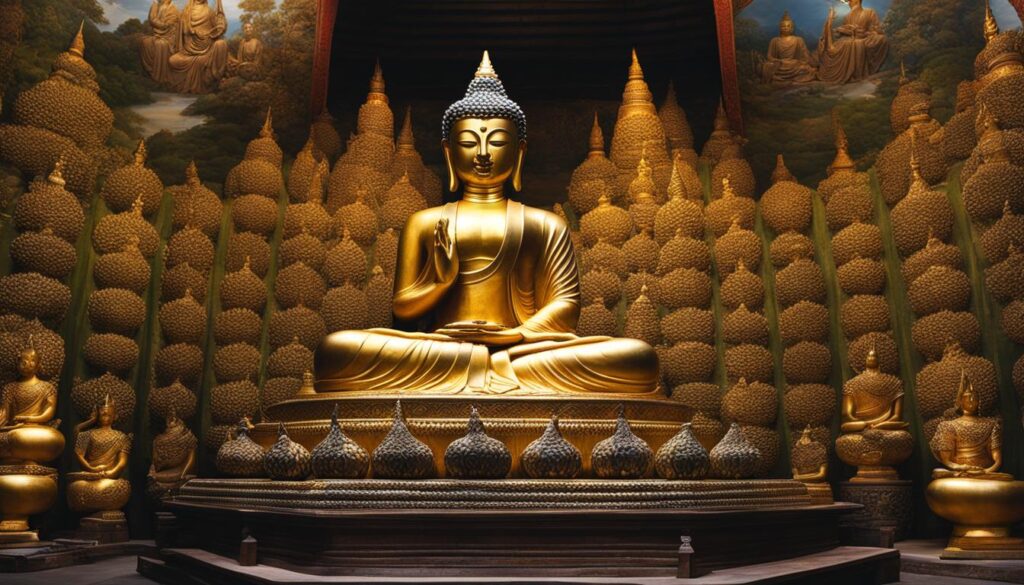
Lesser-Known Buddha Statues and Iconography
While the meditating and reclining Buddha statues are widely recognized, Buddhism also encompasses a rich array of lesser-known statues and iconography. These intricately carved sculptures hold significant spiritual meaning and offer a deeper understanding of Buddhist symbolism. Let’s explore some of these lesser-known Buddha statues and their unique characteristics.
Thousand-Handed Avalokiteshvara
One such lesser-known statue is the Thousand-Handed Avalokiteshvara, a bodhisattva revered for their compassionate nature. Depicted with multiple arms, each adorned with an eye, this statue symbolizes the ability to extend help and compassion to countless beings simultaneously. It represents the limitless capacity of compassion and the interconnectedness of all living beings.
“The Thousand-Handed Avalokiteshvara exemplifies the Buddhist ideal of compassion and the aspiration to alleviate suffering.”
Diamond Sutra Buddha
Another lesser-known Buddha statue is the Diamond Sutra Buddha, which holds the sacred Diamond Sutra text in its hand. This statue signifies the profound teachings of the Diamond Sutra, one of the most important Mahayana Buddhist texts. It emphasizes the impermanence of all phenomena and the need to cultivate wisdom to transcend suffering.
Green Tara
The Green Tara statue represents the compassionate and protective female deity in Tibetan Buddhism. Often depicted in a seated or standing posture, Green Tara is known for her swift action in assisting practitioners in times of difficulty. This statue symbolizes enlightened activity and the nurturing qualities of the divine feminine.
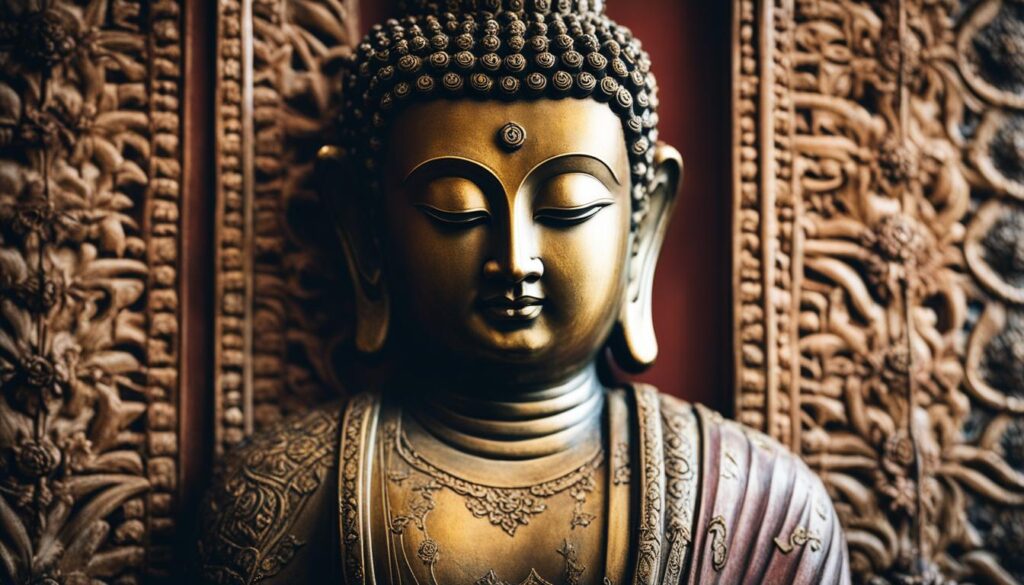
These lesser-known Buddha statues and iconography provide a glimpse into the diverse and profound world of Buddhist symbolism. Each statue carries its own unique meaning and serves as a visual representation of important Buddhist teachings and principles. Whether it’s the Thousand-Handed Avalokiteshvara, the Diamond Sutra Buddha, or the Green Tara, these statues inspire devotion, compassion, and a deep connection to the spiritual path.
Contemporary Interpretations of Buddha Statues
While traditional Buddha statues continue to hold significance and reverence in Buddhism, contemporary artists have also embraced the opportunity to create innovative interpretations of these iconic figures. These modern interpretations often incorporate unique materials, styles, and cultural influences, giving rise to a new wave of Buddha artwork that captivates and inspires.
Contemporary Buddha statues are not bound by strict conventions or traditional designs. Artists have the freedom to experiment with different forms, sizes, and even colors, resulting in a diverse range of interpretations that cater to various preferences and aesthetics. These modern creations offer a fresh perspective on the timeless wisdom of Buddhism, encouraging dialogue and exploration of the teachings in new and exciting ways.
One of the notable trends in contemporary Buddha statues is the fusion of traditional craftsmanship with modern materials. Artists may combine traditional sculpting techniques with elements of glass, ceramic, or even recycled materials to create visually striking and thought-provoking pieces. This blending of old and new not only showcases the artists’ creativity but also highlights the continued relevance of Buddhism in today’s world.
Another aspect of contemporary Buddha statues is the incorporation of cultural influences from different regions. Artists may draw inspiration from various artistic traditions, such as Japanese Zen aesthetics or Thai sculpting techniques, to infuse their creations with a unique cultural flair. These cross-cultural interpretations serve as a testament to the global reach and adaptability of Buddhism as it continues to resonate with people from diverse backgrounds.
Inspiring Serenity through Modern Design
“Contemporary Buddha statues offer a harmonious blend of tradition and innovation, inviting viewers to pause, reflect, and find inner peace in a rapidly changing world.”
The contemporary interpretations of Buddha statues not only serve as aesthetic pieces but also act as catalysts for introspection and mindfulness. With their modern design elements and artistic expressions, these statues have the power to inspire serenity and contemplation in individuals, regardless of their religious or cultural backgrounds.
As the world continues to evolve, contemporary Buddha statues provide a bridge between tradition and the contemporary landscape, offering new ways to connect with the timeless teachings of Buddhism. These artworks invite us to explore the profound wisdom of the Buddha in a way that is relevant and meaningful to our modern lives.
Table: Materials Used in Contemporary Buddha Statues
| Material | Description |
|---|---|
| Resin | Provides a durable and lightweight option for intricate designs |
| Stone | Offers a timeless and natural aesthetic, with variations in color and texture |
| Wood | Creates a warm and organic feel, often showcasing the natural grain of the wood |
| Metal | Brings a sleek and contemporary look, suitable for minimalist designs |
| Glass | Offers a transparent and ethereal quality, allowing light to play with the statue’s form |
The use of various materials in contemporary Buddha statues not only enhances their visual appeal but also adds layers of symbolism and meaning. Each material carries its own unique qualities, allowing artists to convey different aspects of the Buddha’s teachings through their choice of medium.
Collecting and Appreciating Buddha Statues
For many individuals, collecting Buddha statues is not only a way to connect with Buddhism but also a means of appreciating the artistry and symbolism behind these sculptures. The market for Buddha statues offers a wide range of options for collectors and enthusiasts, with various styles, materials, and sizes available. Whether you are a seasoned collector or a beginner looking to start your collection, there are a few key aspects to consider.
Choosing the Right Buddha Statue
When collecting Buddha statues, it is important to choose pieces that resonate with your personal beliefs and aesthetic preferences. Consider the specific symbolism and meaning behind each statue, as different postures, hand gestures, and facial expressions convey unique messages. For example, a meditating Buddha statue represents inner peace and mindfulness, while a laughing Buddha symbolizes happiness and abundance.
Additionally, pay attention to the material and craftsmanship of the statue. Buddha statues can be crafted from various materials such as bronze, wood, stone, or even precious metals. Each material carries its own significance and adds to the overall beauty of the sculpture. Look for high-quality craftsmanship and attention to detail when selecting a statue for your collection.
Caring for Your Buddha Statues
Once you have acquired Buddha statues for your collection, it is essential to take proper care of them to ensure their longevity. Keep the statues in a clean and dust-free environment, as accumulation of dust can deteriorate the surface over time. Avoid exposing the statues to direct sunlight or extreme temperatures, as these can cause fading or damage to the materials.
Regularly clean the statues using a soft cloth or brush to remove any dust or dirt. Avoid using harsh cleaning agents, as they can potentially harm the surface of the statue. Instead, opt for mild soap and water for gentle cleaning. If your statues are made of metal, consider applying a thin layer of wax to protect the surface.
Appreciating the Artistry and Symbolism
As you build your collection of Buddha statues, take the time to appreciate the artistry and symbolism behind each piece. Each statue tells a story and represents the profound teachings of Buddhism. Display your statues in a way that allows you to admire and reflect upon their beauty and spiritual significance. Consider creating a dedicated space in your home or meditation area where you can cultivate a sense of serenity and contemplation.
By collecting and appreciating Buddha statues, you can deepen your understanding of Buddhism and cultivate a sense of tranquility in your life. These timeless sculptures serve as tangible reminders of wisdom, peace, and spiritual awakening. Whether you choose to display a single statue or curate an extensive collection, each piece can bring a sense of inspiration and harmony to your surroundings.
The Spiritual Significance of Buddha Statues
Buddha statues hold deep spiritual significance for Buddhists. They serve as reminders of the Buddha’s teachings, symbolize enlightenment and liberation from suffering, and inspire practitioners on their spiritual path. The presence of a Buddha statue can create a sacred and serene atmosphere, fostering introspection and mindfulness.
One of the main prayer tools in Buddhism is the act of paying homage and offering reverence to Buddha statues. This practice involves bowing or prostrating in front of the statue as a sign of respect and devotion. By performing these gestures, practitioners express their gratitude for the Buddha’s teachings and reinforce their commitment to following the path to enlightenment.
Buddha statues also serve as a focal point for meditation. Many practitioners choose to meditate in front of a statue, using it as a visual aid to cultivate inner peace and concentration. The presence of the statue helps practitioners anchor their attention, bringing them into a state of mindfulness and deepening their connection with the Buddha’s teachings.
“The presence of a Buddha statue can create a sacred and serene atmosphere, fostering introspection and mindfulness.”
Buddhist Sculptures and Materials
Throughout history, Buddha statues have been created using a wide range of materials, each holding its own symbolic meaning. Traditional materials include bronze, marble, wood, and stone. Each material conveys different qualities and aesthetics, adding depth to the spiritual significance of the statue. For example, a bronze statue may represent strength and durability, while a wooden statue may symbolize natural beauty and impermanence.
| Buddha Statue Materials | Symbolism |
|---|---|
| Bronze | Strength, durability |
| Marble | Purity, clarity |
| Wood | Impermanence, natural beauty |
| Stone | Stability, groundedness |
Over time, the design and style of Buddha statues have also evolved, reflecting the cultural and artistic influences of different regions. From the ancient Gandhara art of the Indian subcontinent to the refined elegance of Thai Buddha statues, each style carries its own unique charm and symbolism. These variations in design contribute to the richness and diversity of Buddhist sculpture across different cultures and sects.
Aside from the well-known Buddha statues, there are also lesser-known Buddhist sculptures that hold significant spiritual meaning. These include depictions of bodhisattvas, enlightened beings who have chosen to postpone their own liberation to assist others on their path to awakening. One such example is the Avalokiteshvara statue, representing compassion and the help extended to multiple beings simultaneously.
- Buddha statues have deep spiritual significance for Buddhists.
- They are used as a focal point for meditation and as an object of reverence.
- Materials used for Buddha statues include bronze, marble, wood, and stone, each carrying its own symbolism.
- There are variations in design and style across different cultures and sects of Buddhism.
- Lesser-known Buddhist sculptures, such as depictions of bodhisattvas, hold spiritual significance.
Conclusion
Statues and images of Buddha are not only objects of beauty and craftsmanship but also powerful symbols of peace, wisdom, and spiritual awakening. These sacred representations of the enlightened one hold deep significance in Buddhism and serve as reminders of the profound teachings. Whether used as artworks or meditation aids, they continue to captivate and uplift people around the world.
These statues and images embody the essence of Buddhism, representing the path to enlightenment and liberation from suffering. They inspire individuals on their spiritual journey, providing a source of inspiration, guidance, and tranquility. The presence of a Buddha statue creates a sacred and serene environment, fostering introspection and mindfulness.
Throughout history, Buddha statues and images have evolved, reflecting the cultural and artistic advancements of different regions. From simple and stylized forms to intricate and detailed designs, these representations showcase the rich diversity of Buddhist art. Additionally, contemporary artists have introduced innovative interpretations, incorporating modern materials, styles, and cultural influences while staying true to the timeless wisdom of Buddhism.
Whether as objects of devotion, artwork, or collectibles, statues and images of Buddha continue to be treasured and appreciated by individuals around the world. They remain powerful symbols of peace, wisdom, and spiritual awakening, providing solace, inspiration, and a profound connection to the teachings of Buddhism.
FAQ
What is the symbolism of Buddha statues?
Buddha statues hold deep symbolism in Buddhism, representing the teachings of the Buddha and serving as reminders of the path to enlightenment.
What are the different types of Buddha statues?
There are various types of Buddha statues, including meditating Buddha, laughing Buddha, reclining Buddha, standing Buddha, medicine Buddha, and walking Buddha, each representing different aspects of the Buddha’s life and teachings.
What materials are used to make Buddha statues?
Buddha statues can be made from materials like stone, wood, metal, and even precious gemstones, with the choice depending on aesthetics, durability, and cultural significance.
How have Buddha statues evolved over time?
Buddha statues have evolved from simple and stylized designs to more intricate and detailed sculptures, reflecting the cultural and artistic advancements of different regions.
What is the significance of Buddha statues in meditation?
Buddha statues serve as focal points during meditation, helping create a sense of calm and mindfulness, and serving as reminders of the Buddha’s teachings and the enlightened state.
What are the regional variations in Buddha statues?
Different regions and cultures have their own unique styles and variations of Buddha statues, such as Thai Buddha statues featuring intricate detailing and Japanese Buddha statues with a more serene appearance.
Are there any lesser-known Buddha statues and iconography?
Yes, there are lesser-known statues and iconography associated with Buddhism, such as the Thousand-Handed Avalokiteshvara, which offers a deeper insight into the rich symbolism of Buddhism.
Are there contemporary interpretations of Buddha statues?
Yes, contemporary artists have created innovative interpretations of Buddha statues, incorporating modern materials, styles, or cultural influences while still maintaining the essence of Buddhist teachings.
Is collecting Buddha statues a popular trend?
Many people collect Buddha statues as a way to connect with Buddhism and appreciate the artistry behind these sculptures, looking for unique and high-quality pieces that resonate with their beliefs and aesthetic preferences.
What is the spiritual significance of Buddha statues?
Buddha statues symbolize enlightenment and liberation from suffering, serving as powerful symbols of peace, wisdom, and spiritual awakening, inspiring practitioners on their spiritual path.
Source Links
- https://medium.com/@inventive_mauve_tortoise_897/discovering-the-serenity-of-reclining-buddha-and-nirvana-buddha-unveiling-the-spiritual-treasures-004e60877fec
- https://medium.com/@inventive_mauve_tortoise_897/unlocking-tranquility-exploring-the-types-and-application-scenarios-of-buddha-statues-59df413d0ec0
- https://www.cleverthai.com/guide-to-reclining-buddha-in-wat-pho/


